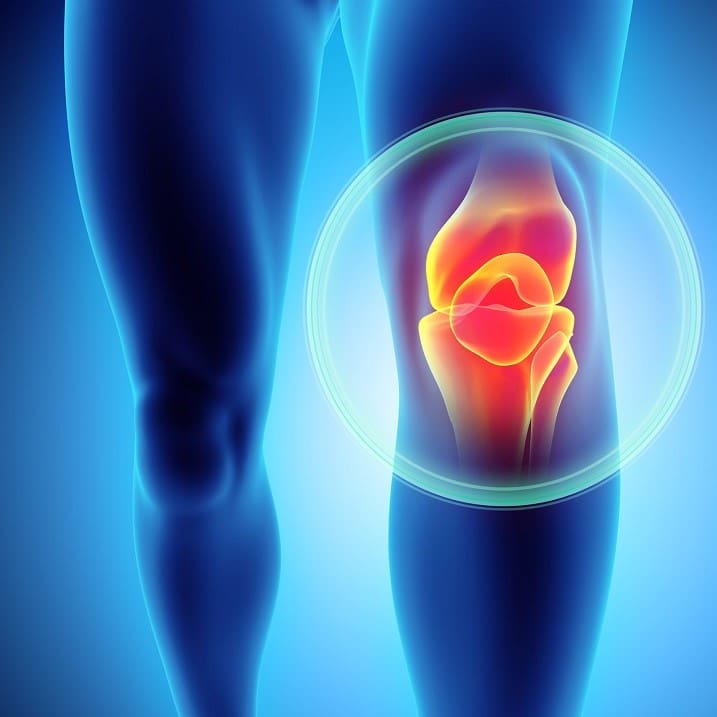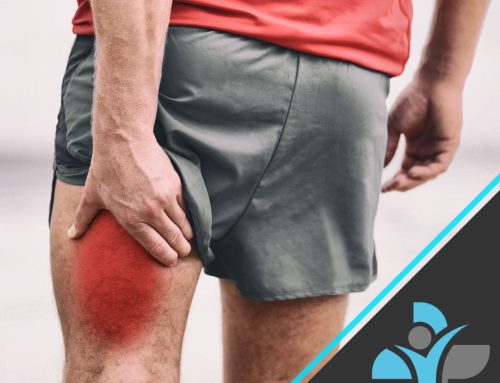
Patellofemoral Syndrome
Overview
Patellofemoral Syndrome (PFS), also known as anterior knee pain, is a condition characterized by irritation or damage to the posterior surface of the patella, the kneecap. This syndrome encompasses a spectrum of severity, ranging from mild dysfunction to more serious and chronic issues. The pain originates from the patellofemoral joint or nearby soft tissues. While previously referred to as anterior knee pain, discomfort associated with PFS can be experienced throughout various regions of the knee.
Anatomically, PFS involves the patellofemoral joint, one of the two major joints in the knee. The patella sits within the femoral groove, and if it is displaced, its sharp undersurface may compress against one side of the femoral groove. The patella is connected to the quadriceps muscle tendon and the patellar ligament, playing a crucial role in knee function.
Anatomy
Patellofemoral Syndrome (PFS) involves the patellofemoral joint, which is a crucial component of the knee anatomy. Here’s a more detailed exploration of the relevant anatomical features associated with PFS:
Patellofemoral Joint: The patellofemoral joint is the articulation between the patella (kneecap) and the femur (thigh bone). This joint allows for smooth movement of the patella as the knee flexes and extends.
Patella (Kneecap): The patella is a sesamoid bone embedded in the tendon of the quadriceps muscle. It plays a vital role in the biomechanics of the knee by providing leverage for the quadriceps and protecting the underlying joint surfaces.
Quadriceps Tendon: The quadriceps tendon attaches the quadriceps muscles (rectus femoris, vastus lateralis, vastus medialis, and vastus intermedius) to the patella. This tendon is essential for the extension of the knee.
Patellar Ligament: The patellar ligament continues from the patella and attaches to the tibial tuberosity on the tibia. This ligament is a continuation of the quadriceps tendon and is involved in knee extension.
Femur: The femur is the long bone of the thigh and forms the upper part of the knee joint. The patella glides in the femoral groove during knee movement.
Femoral Groove: The femoral groove is a groove or channel on the femur where the patella moves as the knee flexes and extends. Any deviation in the alignment of the patella within this groove can contribute to PFS.
Quadriceps Vastus Medialis Obliquus (VMO): The VMO is a specific part of the quadriceps muscle located on the inner side of the thigh. It plays a crucial role in stabilizing the patella and preventing lateral displacement.
Meniscus: The menisci (medial and lateral) are crescent-shaped cartilaginous structures located between the femur and tibia. They contribute to shock absorption and load distribution within the knee joint.
Ligaments:
Ligaments around the knee contribute to stability:
Medial Collateral Ligament (MCL): Stabilizes the inner side of the knee.
Lateral Collateral Ligament (LCL): Stabilizes the outer side of the knee.
Anterior Cruciate Ligament (ACL) and Posterior Cruciate Ligament (PCL):
Cruciate ligaments within the joint that control anterior and posterior movement.
Understanding the specific anatomy involved in PFS is crucial for recognizing factors that may contribute to the development of this syndrome. Issues such as malalignment, muscle imbalances, or abnormal patellar tracking can disrupt the normal function of the patellofemoral joint, leading to pain and dysfunction. Proper diagnosis and treatment often involve addressing these anatomical aspects through targeted interventions such as physical therapy, strengthening exercises, and biomechanical assessments.
Symptoms
Patellofemoral syndrome, also known as patellofemoral pain syndrome (PFPS), is a condition characterized by pain in the front of the knee, around the patella (kneecap) and the surrounding area. It is a common cause of knee pain, especially among athletes and individuals engaged in activities that involve repetitive knee motion. The symptoms may include:
• Pain around the kneecap: The primary symptom is usually a dull, aching pain in the front of the knee, especially around or behind the patella. The pain may be aggravated by activities such as climbing stairs, sitting for long periods with the knee bent, or engaging in activities that stress the knee joint.
• Pain during or after activities: Pain may increase during activities that involve bending the knee, such as running, jumping, squatting, or sitting with the knee bent for an extended period.
• Crepitus or grinding sensation: Some individuals with patellofemoral syndrome may experience a grating or grinding sensation (crepitus) when moving the knee.
• Swelling and inflammation: The knee may exhibit signs of swelling or puffiness around the patella.
• Instability or weakness in the knee: Weakness or a feeling of instability in the knee can be present, making it challenging to perform certain activities.
• Pain when sitting for prolonged periods: Individuals with patellofemoral syndrome may experience discomfort when sitting for extended periods, especially with the knee bent, such as during long car rides or at a desk.
It’s important to note that the symptoms of patellofemoral syndrome can vary from person to person, and the severity of symptoms may fluctuate over time. If you suspect you have patellofemoral syndrome or are experiencing persistent knee pain, it is advisable to consult with a healthcare professional, such as a doctor or physical therapist, for an accurate diagnosis and appropriate management plan. Treatment often involves addressing contributing factors, such as muscle imbalances, and implementing exercises and strategies to improve knee function and reduce pain.
Causes
The exact cause of patellofemoral syndrome (PFPS) can be multifactorial, and it often results from a combination of various factors. Some common causes and contributing factors to the development of PFPS include:
• Overuse or Excessive Training: Activities that involve repetitive knee motion, such as running, jumping, or squatting, can lead to overuse of the patellofemoral joint, contributing to the development of PFPS.
• Muscle Imbalances: Weakness or imbalance in the muscles around the knee, particularly the quadriceps (front thigh muscles) and the muscles that make up the hip, can affect the alignment of the patella within its groove. This imbalance may lead to increased stress on the patellofemoral joint.
• Poor Biomechanics: Abnormalities in the way the lower limb moves, such as issues with foot pronation (rolling inward) or supination (rolling outward), can affect the alignment of the patella and contribute to PFPS.
• Flat Feet or Overpronation: Individuals with flat feet or excessive pronation may have altered biomechanics that can lead to increased stress on the patellofemoral joint.
• Malalignment of the Patella: Anatomical factors, such as a misalignment of the patella within its groove, may contribute to PFPS. This can be influenced by factors like the shape and structure of the knee joint.
• Trauma or Injury: Direct trauma to the kneecap or the surrounding structures can contribute to the development of PFPS.
• Tightness or Weakness in the Hamstrings: Imbalances between the quadriceps and hamstring muscles can affect knee joint mechanics, potentially contributing to PFPS.
• Improper Footwear: Wearing shoes that do not provide proper support or that exacerbate biomechanical issues can contribute to PFPS.
• Joint Laxity: Some individuals may have increased joint laxity, which can affect the stability of the patellofemoral joint.
• Changes in Physical Activity: Sudden increases in intensity, duration, or frequency of physical activity can contribute to the development of PFPS.
It’s important to note that these factors alone are not necessarily the only cause, and often, a combination of them may contribute to the development of patellofemoral syndrome. Additionally, individual variations in anatomy and biomechanics can play a role.
Diagnosis
Diagnosing patellofemoral syndrome (PFPS) typically involves a comprehensive evaluation by a healthcare professional. This may include a thorough medical history, a physical examination, and in some cases, imaging studies. Here is an overview of the diagnostic process for PFPS:
• Your doctor or physical therapist will start by asking about your symptoms, including the nature and location of the knee pain, factors that aggravate or alleviate the pain, and any relevant medical history or previous injuries.
• A physical examination will be conducted to assess various aspects of your knee function. This may involve how you walk, assessing the alignment of your lower limbs, and checking for signs of muscle imbalances or weakness. The healthcare provider may also perform specific manoeuvres to reproduce or exacerbate your symptoms.
• Your healthcare provider may palpate (feel) around various structures around the knee, including the patella, to identify areas of tenderness or swelling.
• The range of motion of the knee joint will be assessed, and strength testing of the muscles around the knee, especially the quadriceps and hamstrings, may be conducted.
• Functional tests, such as evaluating your ability to perform specific movements like squatting or climbing stairs, may be used to assess how your knee functions during activities that can aggravate PFPS.
• While the diagnosis of PFPS is often based on clinical evaluation, imaging such as X-rays or MRIs (Magnetic Resonance Imaging) may be ordered to rule out other structural issues and to assess the alignment of the patella and the condition of the surrounding structures.
It’s important to note that the diagnosis of PFPS is often one of exclusion, meaning other knee pain causing factors will be ruled out first.
Treatment
The treatment of patellofemoral syndrome (PFPS) usually involves a combination of conservative measures aimed at reducing pain, improving knee function, and addressing underlying contributing factors. Here are common treatment approaches:
Rest from activities that exacerbate symptoms can help reduce inflammation and pain.
Modifying or temporarily avoiding activities that involve repetitive knee motion, such as running or jumping, may be beneficial.
A physical therapist can design a specific exercise program to strengthen the muscles around the knee, particularly the quadriceps and hip muscles. These can be physiotherapists, sports therapists or personal trainers.
Stretching exercises to improve flexibility in the muscles and tissues around the knee.
Sports Massage or Deep Tissue Massage performed by a qualified therapist who has level 4 or above.
Patellar taping or bracing may be used to help stabilize the patella.
Orthotics and Footwear:
Custom orthotics or supportive footwear may be recommended to address issues related to foot pronation or other biomechanical factors.
Over-the-counter pain medications, such as acetaminophen or nonsteroidal anti-inflammatory drugs (NSAIDs), may be recommended for pain relief.
Ice application can help reduce inflammation. Applying an ice pack to the affected area for about 15-20 minutes at a time can be effective.
Guidance on modifying activities or exercises to reduce stress on the patellofemoral joint.
Evaluation of gait and lower limb biomechanics to identify and address any issues contributing to PFPS.
Maintaining a healthy body weight can help reduce stress on the knee joints.
In some cases, a healthcare provider may recommend corticosteroid injections to reduce inflammation and pain. However, these are typically used judiciously due to potential side effects.
Surgery is rarely the first-line treatment for PFPS. However, in cases where conservative measures are not effective, surgical options such as arthroscopy may be considered. This might involve procedures to address structural issues or correct biomechanical problems.
It’s important to note that the effectiveness of treatment can vary from person to person, and a tailored approach is often necessary. It’s recommended to consult with a healthcare professional, such as an orthopaedic specialist or physical therapist, to determine the most appropriate treatment plan based on individual circumstances. Additionally, early intervention and adherence to recommended exercises and modifications are crucial for successful management of PFPS.
Exercises
Exercise is a key component of the treatment plan for patellofemoral syndrome (PFPS). The goal of exercises is to strengthen the muscles around the knee, improve flexibility, and address any muscle imbalances or weaknesses that may be contributing to the pain. Here are some exercises that are commonly recommended for individuals with PFPS. However, it’s crucial to consult with a healthcare professional or a physical therapist before starting any new exercise program, as the specific exercises should be tailored to individual needs and capabilities.
Quad Sets:
Sit or lie down with your leg extended.
Tighten the muscles on the top of your thigh and push the back of your knee into the surface you’re sitting or lying on.
Hold for a few seconds, then relax.
Repeat for several sets.
Straight Leg Raises:
Lie on your back with one leg straight and the other bent.
Lift the straight leg a few inches off the ground and hold for a few seconds.
Slowly lower the leg back down.
Repeat for several sets on each leg.
Wall Sits:
Stand with your back against a wall and slide down into a sitting position, as if you were sitting in an imaginary chair.
Hold the position for 20-30 seconds.
Stand back up and repeat for several sets.
Step-Ups:
Use a sturdy step or platform.
Step up onto the platform with one foot, then bring the other foot up.
Step back down, leading with the same foot.
Repeat for several sets, alternating legs.
Clamshell Exercise:
Lie on your side with your hips and knees bent at a 90-degree angle.
Keeping your feet together, lift the top knee while keeping the feet together.
Lower the knee back down.
Repeat for several sets on each side.
Lateral Leg Raises:
Lie on your side with the bottom leg bent slightly for support.
Lift the top leg to the side, keeping it straight.
Lower the leg back down.
Repeat for several sets on each side.
Hamstring Stretch:
Sit on the floor with one leg extended and the other bent so that the sole of your foot is against the inner thigh of the extended leg.
Reach toward the toes of the extended leg while keeping your back straight.
Hold the stretch for 20-30 seconds and then switch legs.
Calf Stretch:
Stand facing a wall with your hands on the wall at shoulder height.
Step one foot back and press the heel into the floor.
Hold the stretch for 20-30 seconds and then switch legs.
Remember to start slowly and gradually increase the intensity and duration of exercises. If you experience increased pain or discomfort during any exercise, it’s important to stop and consult with your healthcare provider or physical therapist. Additionally, consistency is key, and performing these exercises regularly as part of a comprehensive rehabilitation program can contribute to improved outcomes for individuals with PFPS.
Prevention
While not all cases of patellofemoral syndrome (PFPS) can be entirely prevented, there are several strategies and lifestyle modifications that can help reduce the risk of developing or exacerbating the condition. Here are some preventive measures:
Strengthening:
Regularly incorporate exercises that focus on strengthening the muscles around the knee, especially the quadriceps, hamstrings, and hip muscles. Strong muscles provide better support to the knee joint.
Flexibility:
Include stretching exercises to maintain flexibility in the muscles and tissues around the knee. This can help prevent muscle imbalances and improve joint function.
Warm-up and Cool Down:
Always warm up before engaging in physical activities or sports. A proper warm-up prepares the muscles and joints for the stresses of exercise. Similarly, cool down with stretching exercises to help prevent stiffness.
Gradual Progression:
Avoid sudden increases in the intensity, duration, or frequency of physical activities. Gradual progression allows your body to adapt to new demands, reducing the risk of overuse injuries like PFPS.
Well Fitted Footwear:
Wear supportive footwear that is appropriate for your activity. Shoes with good arch support and shock absorption can help maintain proper biomechanics and reduce stress on the knee joint.
Maintaining a Healthy Weight:
Excess body weight can contribute to increased stress on the knee joints. Maintaining a healthy weight through a balanced diet and regular exercise can reduce the risk of PFPS.
Biomechanical Assessment:
If you have concerns about your gait or lower limb biomechanics, consider consulting with a healthcare professional or a physical therapist for a biomechanical assessment. Addressing any abnormalities early on can help prevent future issues.
Cross-Training:
Engage in a variety of physical activities to avoid overuse of specific muscle groups or joints. Cross-training can help distribute the workload and reduce the risk of repetitive strain injuries.
Good Technique:
Ensure proper technique when participating in sports or exercises. Improper form can contribute to increased stress on the knee joint and may lead to overuse injuries.
Listen to Your Body:
Pay attention to any signs of pain or discomfort during physical activities. If you experience persistent knee pain, consult with a healthcare professional for evaluation and appropriate management.
It’s important to note that individual factors, such as anatomy and genetics, can also influence the risk of developing PFPS. While these preventive measures can help reduce the risk, there is no one-size-fits-all approach. If you have concerns about your knee health or are experiencing persistent pain, it is advisable to consult with a healthcare professional for personalized guidance and recommendations.



